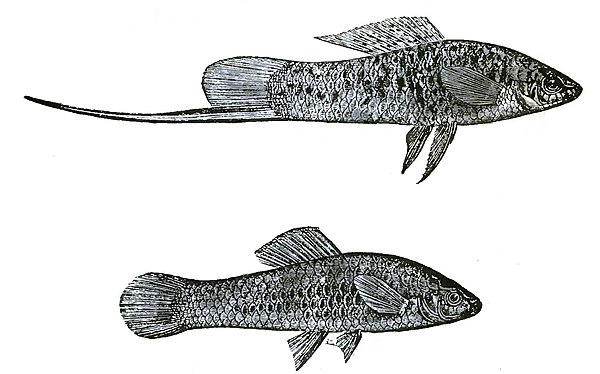their mates."[1] The young males resemble the adult females in structure and colour. Throughout the genus Callionymus,[2] the male is generally much more brightly spotted than the female, and in several species, not only the dorsal, but the anal fin is much elongated in the males.
The male of the Cottus scorpius, or sea-scorpion, is slenderer and smaller than the female. There is also a great difference in colour between them. It is difficult, as Mr. Lloyd[3] remarks, "for any one, who has not seen this fish during the spawning-season, when its hues are brightest, to conceive the admixture of brilliant colours with which it, in other respects so ill-favoured, is at that time adorned." Both sexes of the Labrus mixtus, although very different in colour, are beautiful; the male being orange with bright blue stripes, and the female bright red with some black spots on the back.
In the very distinct family of the Cyprinodontidæ—inhabitants of the fresh waters of foreign lands—the sexes sometimes differ much in various characters. In the male of the Mollienesia petenensis,[4] the dorsal fin is greatly developed and is marked
- ↑ 'Nature,' July 1873, p. 264.
- ↑ 'Catalogue of Acanth. Fishes in the British Museum,' by Dr. Günther, 1861, pp. 138–151.
- ↑ 'Game Birds of Sweden,' &c., 1867, p. 466.
- ↑ With respect to this and the following species I am indebted to Dr. Günther for information: see also his paper on the 'Fishes of Central America,' in 'Transact. Zoolog. Soc.' vol. vi. 1868, p. 485.

